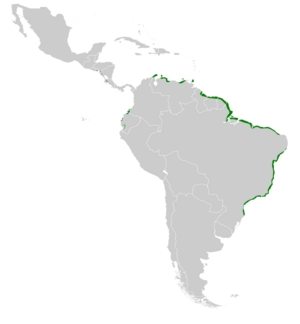Mangrove rail facts for kids
Quick facts for kids Mangrove rail |
|
|---|---|
| Conservation status | |
| Scientific classification | |
| Genus: |
Rallus
|
| Species: |
longirostris
|
 |
|
The mangrove rail (Rallus longirostris) is a type of bird that belongs to the rail family. These birds are found in Central and South America. They often live in coastal areas like mangrove swamps.
Contents
About the Mangrove Rail
The mangrove rail was first described in 1781 by a French scientist named Georges-Louis Leclerc. Later, in 1783, a Dutch naturalist named Pieter Boddaert gave it the scientific name Rallus longirostris. The name longirostris comes from Latin words meaning "long-billed," which describes its beak.
For a long time, scientists thought the mangrove rail was the same species as a few other types of rails, like the king rail. However, a study in 2013 showed that the mangrove rail is its own unique species. This was based on looking at their genes and how they look.
There are eight different groups, or subspecies, of mangrove rails:
- R. l. phelpsi
- R. l. dillonripleyi
- R. l. margaritae
- R. l. pelodramus
- R. l. longirostris
- R. l. crassirostris
- R. l. cypereti
- R. l. berryorum
What Does It Look Like?
The mangrove rail is about 33 cm (13 in) long. It usually weighs between 260 to 310 g (9.2 to 11 oz). It has a long, thin beak that curves slightly downwards. The top part of its beak is brownish, and the bottom part is orange-yellow. Its legs are a light orange-red color. Both male and female mangrove rails look similar.
Adults of the main subspecies, R. l. longirostris, have dull gray-brown feathers on their upper body. Their faces are pale gray with a white stripe near their eyes. They have a whitish throat, a buff-colored neck and chest, and a white belly. Their sides have black and white stripes. Young mangrove rails look like adults but are a bit darker and duller.
Some subspecies have slightly different looks:
- R. l. phelpsi has a darker head and upper body, but lighter underparts.
- R. l. margaritae is the darkest subspecies and is smaller. It also has bolder stripes on its sides.
- R. l. pelodramus is similar in size to margaritae but is lighter in color.
- R. l. cypereti has lighter dark markings on its upper body and lighter stripes on its sides.
Where Do They Live?
Mangrove rails are found in different parts of Central America and along the Pacific, Caribbean, and Atlantic coasts of South America. They live in coastal areas, especially in mangrove swamps and salty marshes.
Here is where each subspecies can be found:
- R. l. phelpsi lives in northeastern Colombia and northwestern Venezuela.
- R. l. dillonripleyi is found in northeastern Venezuela.
- R. l. margaritae lives on Margarita Island off the coast of Venezuela.
- R. l. pelodramus is found on the island of Trinidad.
- R. l. longirostris lives in Guyana, Suriname, and French Guiana.
- R. l. crassirostris is found in Brazil, from the Amazon River south to Santa Catarina state.
- R. l. cypereti lives from southwestern Colombia through Ecuador into Peru.
- R. l. berryorum is found in El Salvador, Honduras, and Nicaragua. Some in northwestern Costa Rica also belong to this group.
Behavior and Life Cycle
Movement
Mangrove rails are known as "sedentary" birds. This means they tend to stay in one area and do not migrate or move around much.
Feeding Habits
These birds usually look for food near places where they can hide. They often hunt when the tide is low, mostly in the morning and early evening. They seem to find food by looking for it, poking their long beaks into sand and mud, and flipping over leaves to find hidden prey. They also catch small fish in shallow water and eat dead fish they find.
Their diet is very varied! They eat many different animals like crabs, crayfish, snails, leeches, and various insects. They also eat fish and small amphibians. Sometimes, they eat plants too, such as seeds, berries, and tubers, especially in the colder months.
Reproduction
The breeding season for mangrove rails changes depending on where they live. However, in most places, they breed during May and June. They build their nests near water, either on the ground or in plants. The nests are made from sticks and dead leaves.
A female mangrove rail usually lays three to seven eggs. Both the male and female birds take turns sitting on the eggs to keep them warm. This incubation period lasts for about 18 to 29 days.
Vocalization
The main sound a mangrove rail makes is a loud, clattering "kek-kek-kek..." call. This call starts fast and then slows down. They make this sound mostly at dawn and dusk. Both male and female birds also make a series of loud, quick "kak" notes to attract a mate. Another call they make is a long, low "raaaaa."
Conservation Status
The IUCN (International Union for Conservation of Nature) has listed the mangrove rail as a species of "Least Concern." This means that, for now, they are not considered to be in immediate danger of disappearing.
Even though they live in a very large area, scientists don't know exactly how many mangrove rails there are. It is believed that their numbers might be going down. Currently, there are no big, immediate threats to them. However, a longer-term concern is the loss and damage of their homes, like mangroves and other wetland areas.


